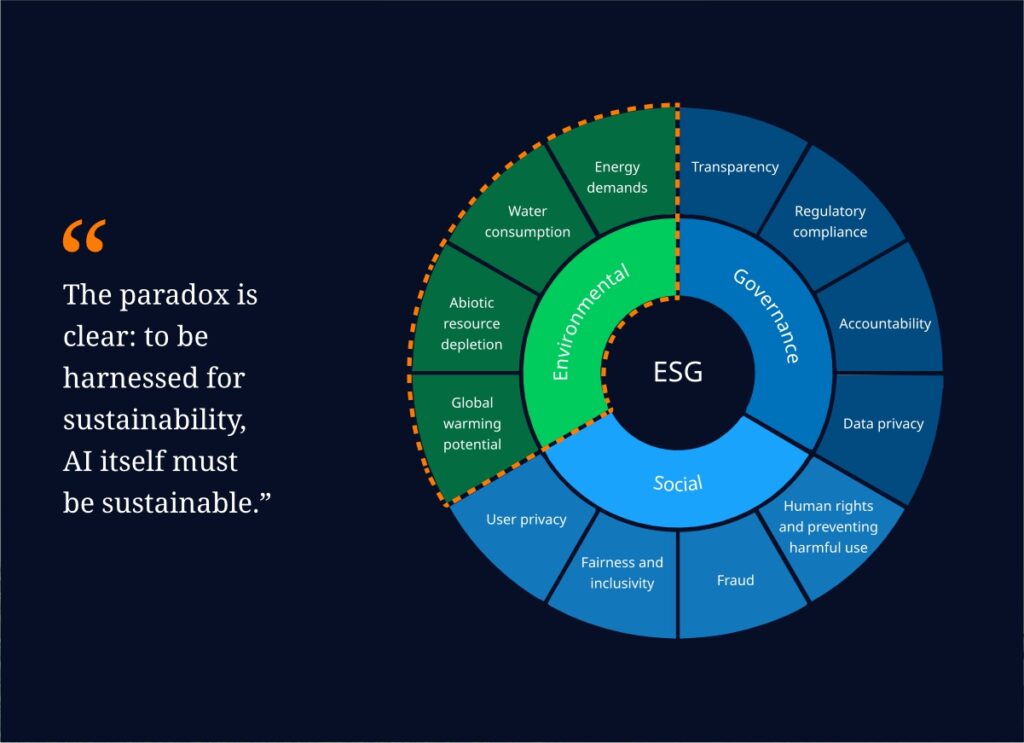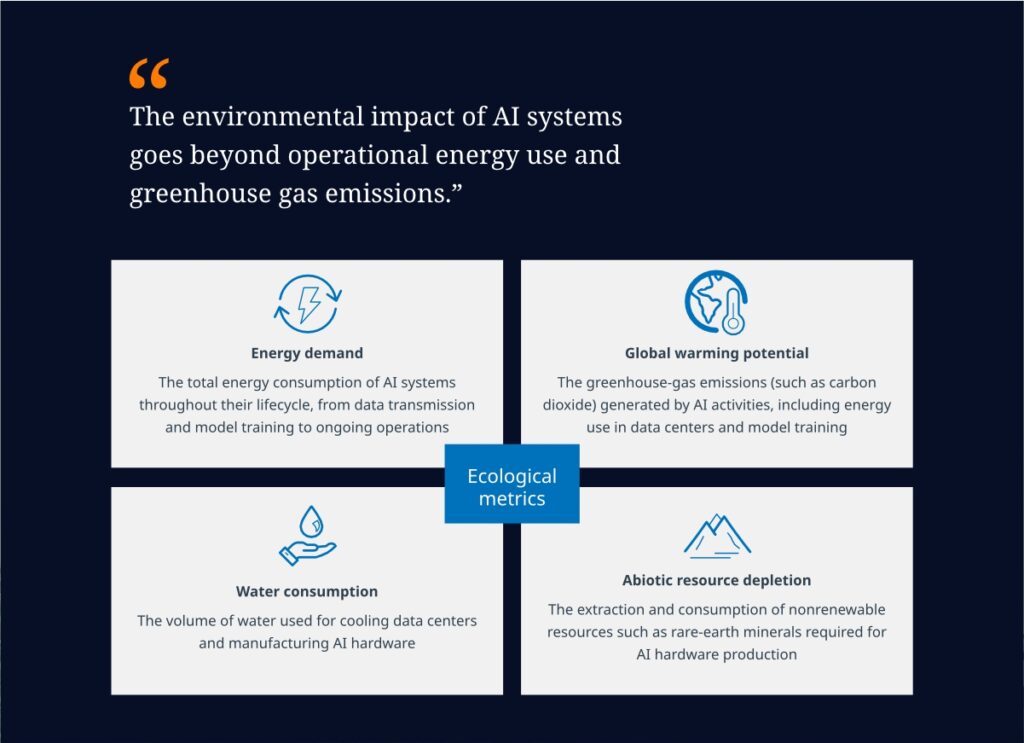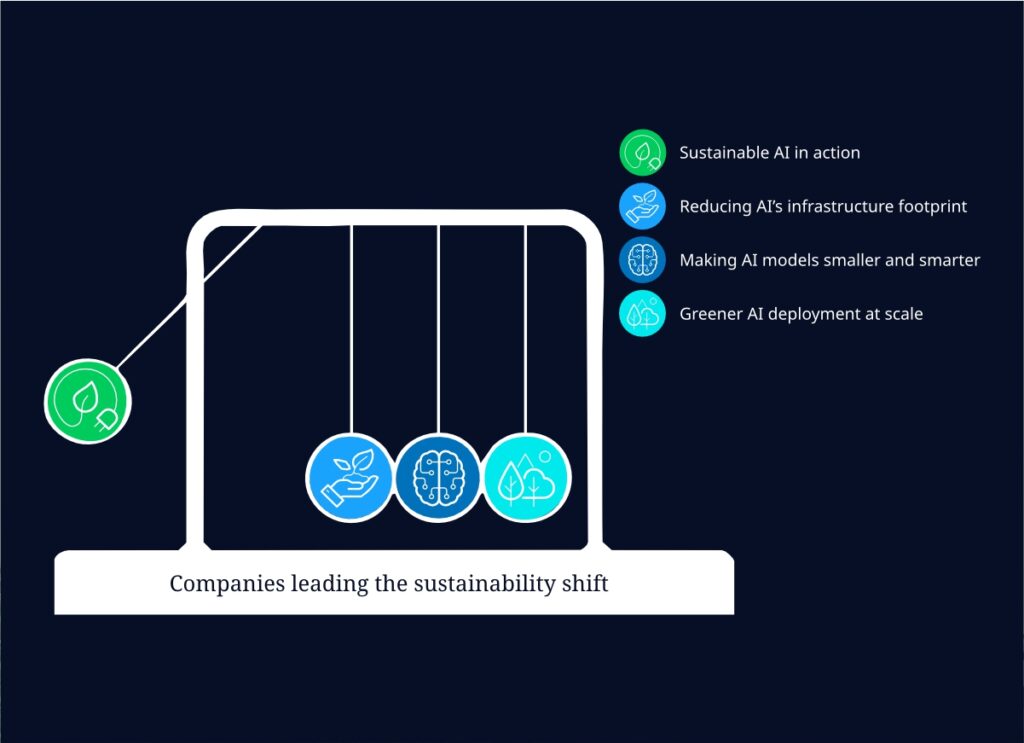Sustainability in AI goes beyond reducing carbon emissions.
Artificial Intelligence (AI) is transforming industries, driving innovation, and shaping economies. Yet, beneath this technological revolution lies an urgent concern: AI’s environmental cost. As algorithms become more complex and data centers expand, AI’s carbon footprint, water consumption, and energy demands are rising rapidly. The need for sustainable AI — technology that is efficient, ethical, and environmentally responsible — has never been more critical.
A recent NTT DATA report titled “Sustainable AI for a Greener Tomorrow” outlines how the future of AI must align with ecological balance. It emphasizes that sustainability should not be a postscript to innovation but a guiding principle woven into every stage of AI’s lifecycle — from data collection to deployment.
The new paper illustrates the growing environmental impact of AI and outlines a path to sustainable innovation. The technology requires enormous volumes of electricity to support surging computational demands to train large language models, run inference pipelines and maintain always-on services. Researchers predict AI workloads will drive more than 50% of data center power consumption by 2028. Other primary environmental impacts include water consumption for data center cooling systems, e-waste and rare earth mineral extraction for hardware production.
***
Rethinking Sustainability in AI
Sustainability in AI goes beyond reducing carbon emissions. It represents a multidimensional balance among environmental, social, and governance (ESG) goals. To build a truly sustainable AI ecosystem, organizations must integrate responsible design, ethical governance, and efficient resource utilization.
AI’s potential to assist in sustainability — for instance, by improving climate modeling, optimizing energy use, or conserving water — is immense. However, if left unchecked, the technology’s computational appetite could offset these benefits. AI models now consume 300,000 times more power than their early predecessors, with projections suggesting that by 2028, AI may account for 22% of all U.S. household electricity consumption. This rapid growth necessitates a systemic change in how AI is developed and deployed.
AI’s potential to solve global challenges is immense — but only if its growth aligns with environmental stewardship.
The transition from performance-driven to planet-driven AI is both urgent and achievable.
“The resource consequences of AI’s rapid growth and adoption are daunting, but the technology also can empower innovative solutions to the environmental problems it creates,” said David Costa, Head of Sustainability Innovation Headquarters, NTT DATA. “AI’s amazing capabilities can help manage energy grids more efficiently, reduce overall emissions, model environmental risks and improve water conservation. It’s vital for organizations to recognize the challenge and build sustainability into AI systems from the start.”

***
The Essence of “Green AI”
Green AI, as defined by NTT DATA, is the development and deployment of AI systems that minimize environmental impact across their entire lifecycle. Unlike “Red AI,” which pursues maximum accuracy at any cost, Green AI focuses on efficiency, sustainability, and accessibility.
Four key metrics define the ecological footprint of AI:
- Energy Demand: The electricity consumed from training to deployment.
Data centers already consume about 1.5% of global electricity, and the figure could rise to over 1,000 TWh by 2026. - Global Warming Potential: The carbon emissions linked to energy use in data centers.
Without decarbonization, emissions could reach 860 million tons of CO₂ by 2030. - Water Consumption: AI cooling systems can consume millions of liters of water for a single large model.
Every 10 to 50 AI queries can use up to 500 ml of water, the equivalent of a small bottle. - Abiotic Resource Depletion: Mining for rare-earth materials like cobalt, lithium, and palladium to make AI hardware intensifies resource scarcity and geopolitical dependence.
Green AI demands conscious decisions in data processing, model design, hardware use, and infrastructure management — all aimed at minimizing waste and maximizing performance.
***
The Ecosystem of Sustainable AI
As technology accelerates, sustainable AI offers humanity a pathway to a smarter and greener tomorrow — one where intelligence, innovation, and integrity converge. Creating sustainable AI is a collective effort involving multiple actors:
- Energy Providers: Must transition AI systems to renewable energy grids.
- Hardware Manufacturers: Should innovate efficient, modular, and recyclable hardware.
- AI Developers and Vendors: Need to prioritize lightweight model architectures and algorithmic efficiency.
- Policymakers: Have a responsibility to introduce frameworks like the EU AI Act or UN AI for Good that enforce responsible development.
- Users and Investors: Must support and demand sustainable AI applications.
- E-waste Managers: Should promote circular economy practices to recycle obsolete hardware.
Responsibility does not rest on one player; collaboration and shared accountability are the only paths forward.
***
Measuring What Matters: Defining Sustainability Metrics
Sustainability can only advance when it is measurable. NTT DATA emphasizes developing standardized metrics for assessing AI’s environmental impact. Unlike industries governed by established frameworks such as the Greenhouse Gas Protocol, AI lacks a universal benchmark.
Lifecycle assessments — covering everything from raw material extraction to end-of-life disposal — are vital. Such frameworks help identify high-impact phases like hardware manufacturing and large-scale model training, which consume disproportionate amounts of energy and resources.
Innovative measurement tools include:
- AI Energy Score (Hugging Face): Rates models by their energy efficiency.
- Compute Carbon Intensity (CCI): Measures the carbon footprint of AI accelerators and hardware.
- Automated Reporting Systems: Enable real-time tracking of energy and emission data across AI infrastructures.
By adopting these tools, organizations can create transparency and encourage data-driven sustainability decisions.
***
From Theory to Action: Best Practices for Sustainable AI
NTT DATA proposes a structured approach to embedding sustainability in AI development:
1. Sustainable by Design
- Incorporate Green Software Patterns and energy-efficient code architectures.
- Focus on smaller, task-specific models rather than massive, resource-hungry ones.
- Adopt standardized sustainability reporting to ensure accountability.
2. Infrastructure Optimization
- Use spatiotemporal scheduling to run AI workloads when renewable energy availability is highest.
- Improve data center efficiency through advanced cooling technologies and energy management systems.
- Implement energy-proportional computing, where power use scales with workload intensity.
3. Closing the Loop
- Employ data deduplication and compression to avoid redundant storage.
- Extend hardware lifecycles via modular design and refurbishment.
- Report disaggregated environmental metrics to prevent burden shifting.
This holistic framework enables organizations to align innovation with ecological responsibility.
***

Real-World Applications: Sustainable AI in Action
NTT DATA showcases three pioneering case studies:
1. Remote GPU Services via All-Photonic Networks (APN)
AI workloads are shifted to energy-optimized data centers, reducing carbon emissions and enhancing training speed.
Dynamic energy management distributes workloads intelligently, allowing organizations to train models sustainably without performance loss.
2. “Tsuzumi”: Low-Carbon Large Language Model
NTT’s tsuzumi-7B model uses quantization and pruning techniques to achieve 250–300x lower training energy and up to 70x lower inference costs than traditional LLMs — proving efficiency and performance can coexist.
3. On-Premises Sustainable AI
By processing AI workloads locally, organizations cut down on data transfer energy costs and reduce dependency on cloud infrastructure, lowering their carbon footprint while retaining control and efficiency.
These initiatives demonstrate that sustainable AI is not theoretical — it is practical, scalable, and already reshaping AI infrastructure.
While the road to sustainable AI is complex, an intentional, end-to-end redesign of the AI lifecycle can help fulfill this technology’s positive potential while protecting the environmental systems on which all living things depend.
***
Collaborative Governance for a Responsible Future
The journey toward sustainable AI demands regulatory coherence and global cooperation. Governments must enforce environmental accountability in AI policy, while industry leaders must commit to transparency in reporting and design.
Embedding sustainability in AI governance frameworks ensures that ecological responsibility becomes a core performance metric, not a marketing claim.
As NTT DATA notes, “Sustainable AI is not a constraint but an opportunity — a chance to redefine how technology serves both business and the planet.”
***

Actors in the Ecosystem of Sustainable AI
Understanding Responsibility Across the AI Lifecycle
To ensure sustainability in Artificial Intelligence (AI), it is essential to understand the distribution of responsibilities across the entire AI lifecycle. Each actor — from energy providers to users and policymakers — plays a critical role in reducing environmental impact, promoting ethical practices, and enhancing long-term sustainability. By assessing their influence, risks, and contributions, we can pinpoint where interventions are most effective and how collective action can shape a sustainable AI future.
1. Energy Providers
Key Role: Powering AI Infrastructure
Energy providers — including utility companies, renewable energy firms, and smart grid operators — supply the electricity that fuels AI data centers and computational clusters. They hold a pivotal responsibility in transitioning AI infrastructure to renewable energy sources, such as solar, wind, and hydroelectric power, while maintaining reliability and efficiency. Their commitment directly affects the carbon footprint of AI systems, making them a cornerstone of sustainable AI development.
2. Hardware Manufacturers
Key Role: Building Energy-Efficient AI Systems
Hardware manufacturers design and produce semiconductors, processors, and AI-specific chips that determine the computational efficiency and energy consumption of AI models. Alongside, cloud and data center operators manage vast storage and computing networks that drive AI workloads. The design choices made at this stage influence the hardware footprint, energy use, and cooling needs, thereby shaping the sustainability outcomes of AI infrastructure.
3. Users
Key Role: Driving Ethical and Responsible Use
Individual and corporate users are the endpoints of the AI ecosystem, engaging with AI tools in daily life and business operations. Their feedback guides continuous improvement, while their behavior — from responsible usage to supporting sustainable AI — influences demand.
Corporate users in sectors like finance, healthcare, retail, and manufacturing play an even greater role by integrating AI into their operations responsibly. Many invest in eco-conscious AI models and sustainable data management practices to ensure environmental and social accountability.
4. AI Ethics and Advocacy Groups
Key Role: Promoting Transparency and Accountability
Beyond corporate governance, academic institutions, non-profits, and watchdog organizations act as external auditors of AI’s ethical and environmental footprint. These groups push for transparency, fairness, and accountability, holding companies and governments responsible for the consequences of AI deployment. Their advocacy ensures that sustainability remains a moral as well as operational priority in AI innovation.
5. Mining Supply Chains
Key Role: Ensuring Ethical Resource Extraction
AI hardware depends heavily on minerals such as lithium, cobalt, and silicon, which are often mined through environmentally damaging methods. The sustainability of AI hardware thus hinges on responsible sourcing and fair labor practices in mining. Strengthening ethical supply chains and embracing recycling and circular-economy models can significantly reduce AI’s ecological and human costs.
6. Technology Investors and Venture Capita
Key Role: Financing Sustainable AI Innovation
Investors and venture capitalists steer the direction of AI development through their funding priorities. When they support energy-efficient computation and green technologies, innovation aligns with sustainability goals. Conversely, funding resource-intensive AI projects accelerates environmental degradation. Investor awareness, consumer pressure, and regulatory incentives are vital for ensuring that financial flows favor environmentally responsible AI ventures.
7. Policymakers and Regulatory Agencies
Key Role: Shaping Policy and Enforcing Standards
Governments and global institutions frame the legal and ethical architecture of sustainable AI. They enforce regulations concerning energy use, carbon reporting, and data ethics. Notable examples include:
- The European Commission’s AI Act promoting safe and transparent AI.
- The UN’s AI for Good initiative, linking AI innovation with the Sustainable Development Goals (SDGs).
- The U.S. National Institute of Standards and Technology (NIST) establishing AI risk management frameworks.
By setting global standards and compliance norms, policymakers ensure accountability and environmental responsibility across AI ecosystems.
8. E-waste Management Providers
Key Role: Building a Circular AI Economy
Obsolete AI hardware generates significant electronic waste, contributing to environmental hazards if not managed properly. E-waste management organizations — such as Umicore, Sims Recycling Solutions, and government-led recycling programs — focus on recovery, recycling, and repurposing of electronic components. Integrating circular economy principles into AI hardware lifecycles helps reduce waste, conserve materials, and lower carbon emissions.
9. AI Vendors
Key Role: Engineering Energy-Efficient Algorithms
AI vendors and developers, including major organizations like OpenAI, DeepMind, Meta AI, Hugging Face, and IBM Watson, are at the forefront of algorithmic sustainability. Their innovations — such as model pruning, quantization, and federated learning — significantly reduce computational demand and power consumption. By designing models that perform efficiently without compromising accuracy, these developers contribute directly to sustainable computing and climate-conscious AI practices.
The ecosystem of sustainable AI is a complex yet interdependent network of stakeholders. From energy producers and hardware makers to policy enforcers and end-users, each actor influences the environmental footprint and ethical direction of artificial intelligence. Sustainable AI is achievable only when all participants coordinate across the value chain, integrating environmental consciousness, technological efficiency, and ethical governance. Together, they can ensure that AI not only transforms industries but also safeguards the planet for future generations.
Terms & Conditions: India CSR does not permit other Websites/agencies to copy or reproduce, or reprint the above article/feature in any form or means.





